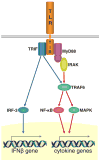The role of Toll-like receptors in CNS response to microbial challenge
- PMID: 16899072
- PMCID: PMC2423668
- DOI: 10.1111/j.1471-4159.2006.04076.x
The role of Toll-like receptors in CNS response to microbial challenge
Abstract
The recent discovery of the family of Toll-like receptors has vastly expanded our understanding of the mechanisms by which the innate immune system recognizes and responds to a wide variety of microbial and endogenous pathogens. Toll-like receptors are transmembrane proteins that upon ligation with their cognate ligands trigger the production of cytokines, enzymes and other inflammatory agents. In the CNS Toll-like receptors are expressed predominantly by glial cells. In particular, the vastly abundant astrocytes are likely to be the major contributors to inflammatory responses within the CNS. Studies of the murine brain abscess model revealed that Toll-like receptor 2 plays a pivotal role in the generation of immune responses to Staphylococcus aureus. Although Toll-like receptor signaling is essential in antimicrobial defense, it may also lead to bystander injury of CNS tissue.
Figures

References
-
- Akira S. Toll-like receptors and innate immunity. Adv Immunol. 2001;78:1–56. - PubMed
-
- Akira S, Takeda K, Kaisho T. Toll-like receptors: critical proteins linking innate and acquired immunity. Nat Immunol. 2001;2:675–680. - PubMed
-
- Akira S, Uematsu S, Takeuchi O. Pathogen recognition and innate immunity. Cell. 2006;124:783–801. - PubMed
-
- Alexopoulou L, Holt AC, Medzhitov R, Flavell RA. Recognition of double-stranded RNA and activation of NF-kappaB by Toll-like receptor 3. Nature. 2001;413:732–738. - PubMed
-
- Baldwin AC, Kielian T. Persistent immune activation associated with a mouse model of Staphylococcus aureus-induced experimental brain abscess. J Neuroimmunol. 2004;151:24–32. - PubMed
Publication types
MeSH terms
Substances
Grants and funding
LinkOut - more resources
Full Text Sources
Other Literature Sources

